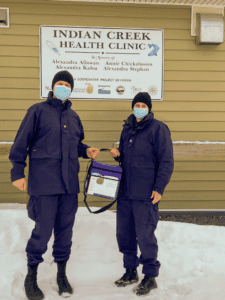Honoring the 100-Year Anniversary of the Great Race of Mercy: A Modern Day Journey of Vaccines to Rural Alaska
By Southcentral Foundation Corporate Communications

Lt. Cmdr. Michael Bakker, ANTHC provider and Cmdr. Kristen Maves, SCF pharmacist, deliver COVID-19 vaccines to Indian Creek Health Clinic in Tyonek.
Whether you are a history buff or a movie fan, chances are you have heard the heroic stories of Togo and Balto and the role they played in 1925 Great Race of Mercy from Nenana to Nome, Alaska. Mushers and their dog teams crossed treacherous terrain during Alaska’s winter to safely bring diphtheria antitoxin to Nome. Without the antitoxin, it was expected that the population of Nome and the surrounding regions, about 10,000 people, would have suffered a nearly 100% mortality rate.
While transportation, communication, and health care have improved over the past 100 years, do you ever wonder how immunizations get to rural communities in 2025? To honor the 100-year anniversary of the Great Race of Mercy, let’s follow the modern journey Southcentral Foundation vaccines take to safely arrive at a rural clinic, and the importance of your role in making and keeping appointments.
It seems simple — you schedule an appointment, you show up, and you get vaccinated. On the back end, however, there are dozens of people including SCF pharmacists, couriers, immunization coordinators, pharmacy technicians, and primary care employees ensuring you receive vaccines efficiently and safely.
A rural vaccine’s journey at SCF starts with an inventory check from the clinic. SCF Pharmacy coordinates with community health centers to determine the quantity of adult and pediatric doses and the date needed.
The first leg of the journey is from the supplier to the Anchorage Native Primary Care Center Pharmacy. Vaccines are delivered from several sources including the Indian Health Service, State of Alaska Epidemiology Department, and McKesson Pharmaceutical Distribution. Upon arrival, all vaccines are inspected, labeled, and sorted. They are stored in a refrigerator or freezer, depending on the type.
“The team’s vaccine coordinator must also indicate in the electronic health record each location the vaccine will be stored, from offsite clinics to the Alaska Native Medical Center, so it can be documented when administered,” SCF Clinical Director Pharmacist Callista Carlton shared.
Before community health centers receive vaccines, they must track the refrigeration temperature twice daily and provide proper documentation that it stays within the appropriate temperature range.
ANPCC Pharmacy then plans the next leg of the vaccine’s journey, shipping to rural Alaska.
“Pharmacy packages vaccines in a VeriCor cooler with a temperature monitoring device that tracks the contents temperature from the moment we hit start and zip the tote, to the moment the clinic receives the cooler and hits stop. Once the tote and log tag are returned to Pharmacy, we can download the data and see that the vaccines stayed within an acceptable temperature range for their journey from Anchorage to the rural site,” Carlton shared. “A pharmacy technician then brings the package to the airfield to depart on the next scheduled flight.”
When the clinics receive the vaccines, they are inspected to ensure the packaging is intact, have remained at the correct temperature, then logged into inventory. When the vaccines are removed, the special cooling totes and temperature monitor devices are sent back to Anchorage.
The final leg of a vaccine’s journey requires you.
Just as the mushers of the Great Race of Mercy did, health care workers go the extra mile to ensure vaccines get to you effectively, safely, and quickly. A lot of work begins behind the scenes when you schedule a vaccine appointment. When you schedule an appointment, be sure to keep the appointment, or let your provider know if you need to reschedule. When one person is immunized, children, parents, and grandparents are all safer from life-threatening disease. Together, we can continue the legacy of protection for generations to come.
To ensure your family’s immunizations are up to date, connect with your integrated care team or visit the State of Alaska VacTrAK website at vactrak.alaska.gov.


